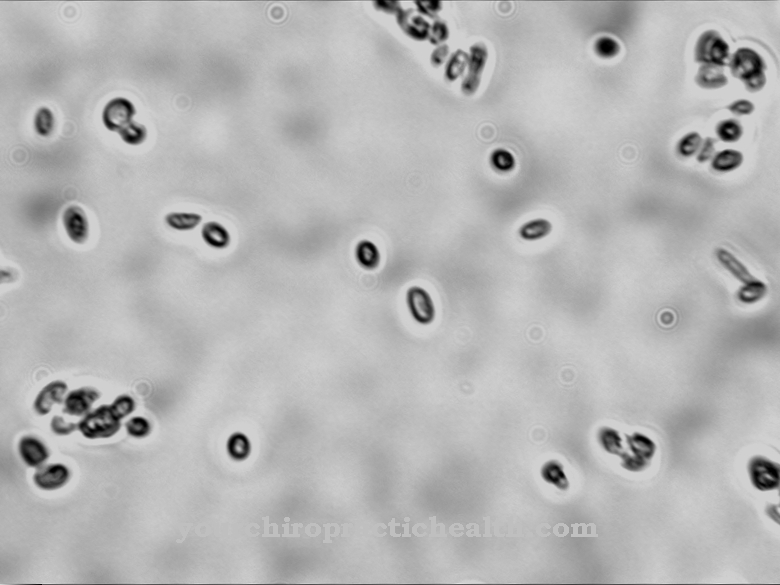The Bacillaceae are gram-positive bacteria from the Bacillales group. A well-known pathogen from this family is Bacillus anthracis, the causative agent of anthrax.
What are Bacillaceae?
Bacillaceae is a family within the species of bacteria. They belong to the order Bacilliales. More than 50 different genera are known within the Bacillaceae family. These include, for example, Amphibacillus, Lentibacillus or Saccharococcus. The best known subgroup, however, is the genus Bacillus, to which pathogens such as Bacillus anthracis, Bacillus cereus or Bacillus stearothermophilus belong.
The Bacillaceae are gram-positive, long rod bacteria. Accordingly, they can be colored blue using the Gram stain. In contrast to the gram-negative bacteria, they only have a thick outer peptidoglycan layer made of murein and no additional cell membrane on their outside.
Many representatives of the Bacillaceae belong to the group of aerobic spore formers. If there is enough oxygen, the bacteria will form spores. These enable the bacteria to survive even under unfavorable conditions. This makes the bacteria more resistant to environmental influences. In their spore form, the Bacillaceae can even survive in 70% alcohol.
Occurrence, Distribution & Properties
Bacillaceae are obligatory aerobic. So they can only exist under oxygen-rich conditions and only multiply if there is enough oxygen. The Bacillaceae live mainly in humus-rich soil. But the bacteria are also found in water, dust, the air and the intestinal tract of animals and humans. Thus they make up a large part of the so-called normal flora. The normal flora describes the entirety of all microorganisms that live in or on the body of a living being.
The pathogens are usually transmitted through direct contact. For example, the bacterium Bacillus anthracis is transmitted through ingestion of contaminated meat. Ingestion is also possible by inhaling infected spores or particles. The anthrax pathogen can reproduce in the carcass even after the death of the infected animal or change to the spore stage. Therefore, animals infected with Bacillus anthracis must be cremated. Otherwise other animals could become infected.
In the case of the Bacillus subtilis pathogen, too, infection occurs through direct contact. In most cases, people become infected from eating contaminated food. Similar to the pathogen Bacillus anthracis, infection is also possible through [[inspiration inhalation of infected spores or particles.
You can find your medication here
➔ Medication for diarrheaIllnesses & ailments
Bacillaceae can be non-pathogenic, facultative pathogenic or obligate pathogenic for humans. Apathogenic bacteria such as Bacillus sporothermodurans are not dangerous to humans. Facultative pathogens such as Bacillus subtilis lead to diseases, especially in people with a suppressed immune system. Obligatory pathogenic agents can cause infections in actually healthy people.
Bacillus subtilis is one of the facultative pathogens. In rare cases, the bacterium can cause non-specific food poisoning. Responsible for this are enzymes in the pathogen, which convert the proteins contained in the food into biogenic amines. This leads to the typical symptoms of vomiting and diarrhea. In the event of food poisoning from Bacillus subtilis, penicillins are used for treatment. As a rule, however, the disease is self-limiting, so that in most cases there is no medication.
It is different with Bacillus anthracis, the causative agent of anthrax. Anthrax is rare in Northern Europe and North America. As a rule, people who are in closer contact with animals are affected. Sheep and cows in particular are carriers of anthrax in Europe. Farmers and veterinarians, for example, are therefore at risk. Clinically, anthrax can be divided into three forms: intestinal anthrax, cutaneous anthrax, and pulmonary anthrax.
The most common form is skin anthrax. After infection, an itchy papule will develop on the skin. The surrounding skin is swollen. Over time, this papule decays and a black necrosis forms in the center. In addition, bubbles appear around the papule. These are also known as pustulae malignae. In intestinal anthrax, severe gastrointestinal inflammation develops with slimy and later bloody diarrhea. The massive increase of Bacillus anthracis in the intestine leads to ulcers and disintegration of the lymph nodes in the abdomen. The most severe form is pulmonary anthrax. The infection begins with flu-like symptoms. Then rapidly progressing pneumonia with severe shortness of breath and fever develops. The mediastinum is also inflamed by the action of the bacterial toxins. The prognosis is poor even with very early treatment. The disease is often fatal. The other forms of the disease can also be fatal due to blood poisoning (sepsis) or damage to the organs. Anthrax is treated with antibiotics given orally or intravenously.
The pathogen Bacillus cereus occurs mainly in raw rice and survives cooking. In particular, when the rice is kept warm or warmed up, the bacteria multiply rapidly. Bacillus cereus produces two different toxins. The emetic toxin (cereulide, vomiting toxin) leads to vomiting and nausea after one to six hours. Those affected rarely suffer from diarrhea and abdominal cramps. The diarrhea toxin causes watery diarrhea 8 to 17 hours after ingesting the contaminated food. These usually subside after a day at the latest.



























